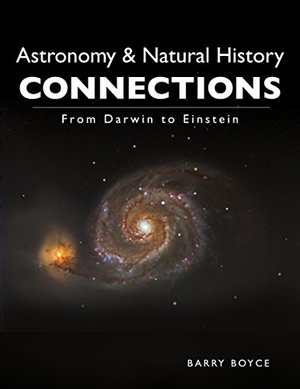If you’ve ever wanted to take a crash course in the sciences, then Astronomy & Natural History Connections: From Darwin to Einstein may just be the book for you. Barry Boyce’s book makes a bold attempt to teach readers about the wonders found around us here on earth, the various marvels of space, and how the two are intrinsically tied together. Written with a more casual tone than you will find with other nonfiction books on the subjects, this book is likely much more approachable to the layman, but is certainly not light on facts!
[alert variation=”alert-info”]Publisher: The Baryon Press
Formats: eBook, Kindle
Purchase: Amazon[/alert]
The book begins with a prolonged description of the kinds of talks that Barry currently gives to people visiting the University of Arizona Skycenter in Tucson, or rather, up on Mount Lemmon. Barry uses these talks to frame the narrative, but drifts back and forth between subjects and stories, which, depending on your reader preference, could help keep readers engaged or end up being distracting. The book continues with a historical run through the ages and the various leaps in our understanding of science, including animal behavior, physics, and astronomy. The book often references the people making the discoveries, lingering on some of the bigger names like Darwin, Aristotle, and Galileo, but also highlighting lesser known contributors such as “the Harvard Computers” – a group of women staff at the Harvard Observatory who worked to process astronomical data and yet, were largely unknown until recently. Barry also taps into his long history running tours around the Galapagos Islands and uses the wildlife there for many of his examples, including the migration and feeding habits of whales, and the mating rituals of the local birdlife.
The book is chock full of information, almost an overwhelming amount of information, though the more casual dialogue will likely allow this information to feel more accessible to some people than the typical textbook style writings. However, his writing style does use an excessive number of asides, both short narrative stories as well as a shocking number of parenthetical asides. The excessive use of parenthesis is very, very obvious and somewhat off-putting, as is the frequent use of bolded text. While it’s clear the bolding is meant to emphasize information that the author considers more important, it’s frankly a bit of an eyesore and probably could have been handled in a different manner. All of this comes down to personal preferences with regards to book layouts, and while it shouldn’t be enough to drive people away, is something that potential readers should be aware of. The book does include a list of sources and recommended readings for people looking for more information on specific topics, and a useful index to hunt down specific facts quickly, both of which are a welcome inclusion.
Astronomy & Natural History Connections is a relatively short book with tons of information crammed inside. A casual, yet informative nonfiction, this is a book could be a great way to brush up on your natural sciences and a welcome read for those willing to take the time to dive in.
[signoff predefined=”Social Media Reminder” icon=”facebook”][/signoff]

